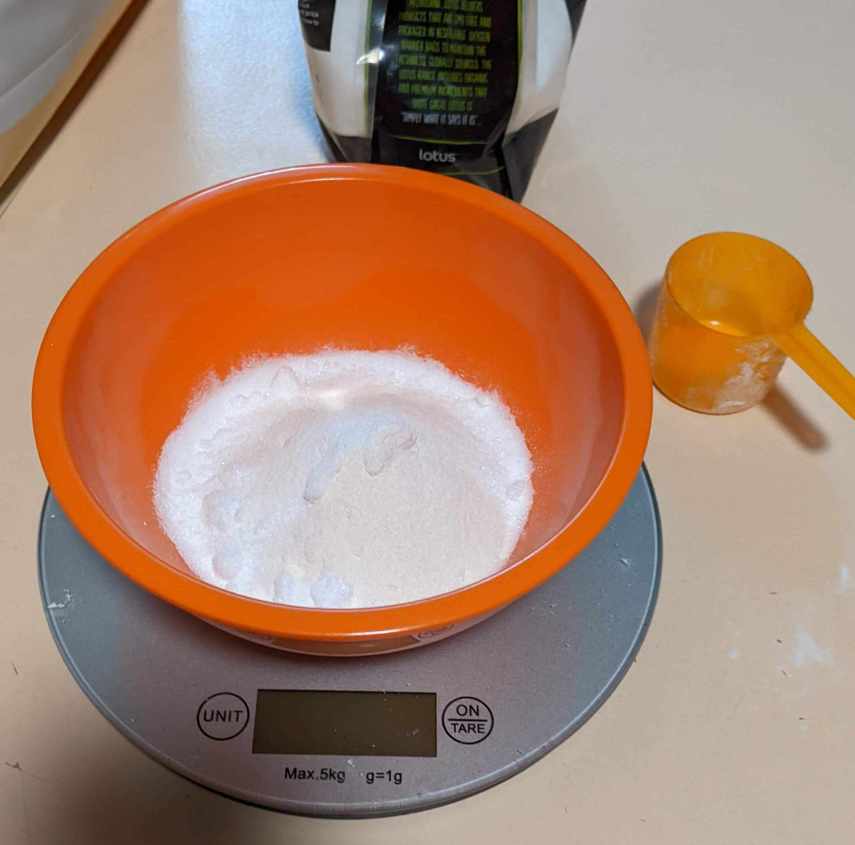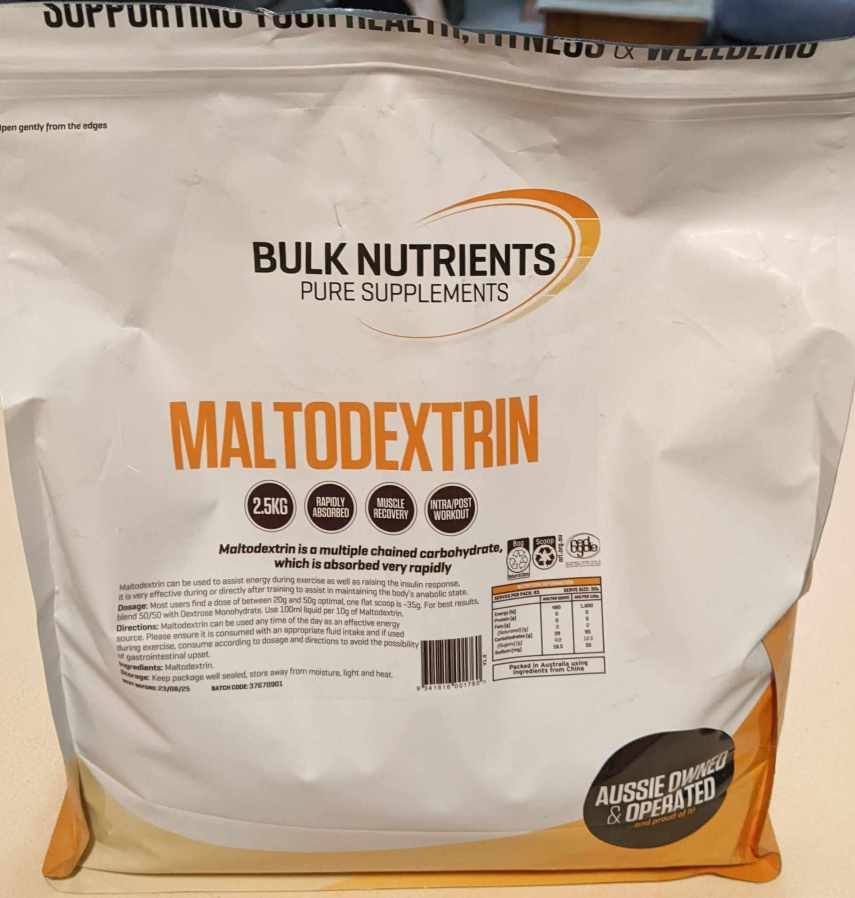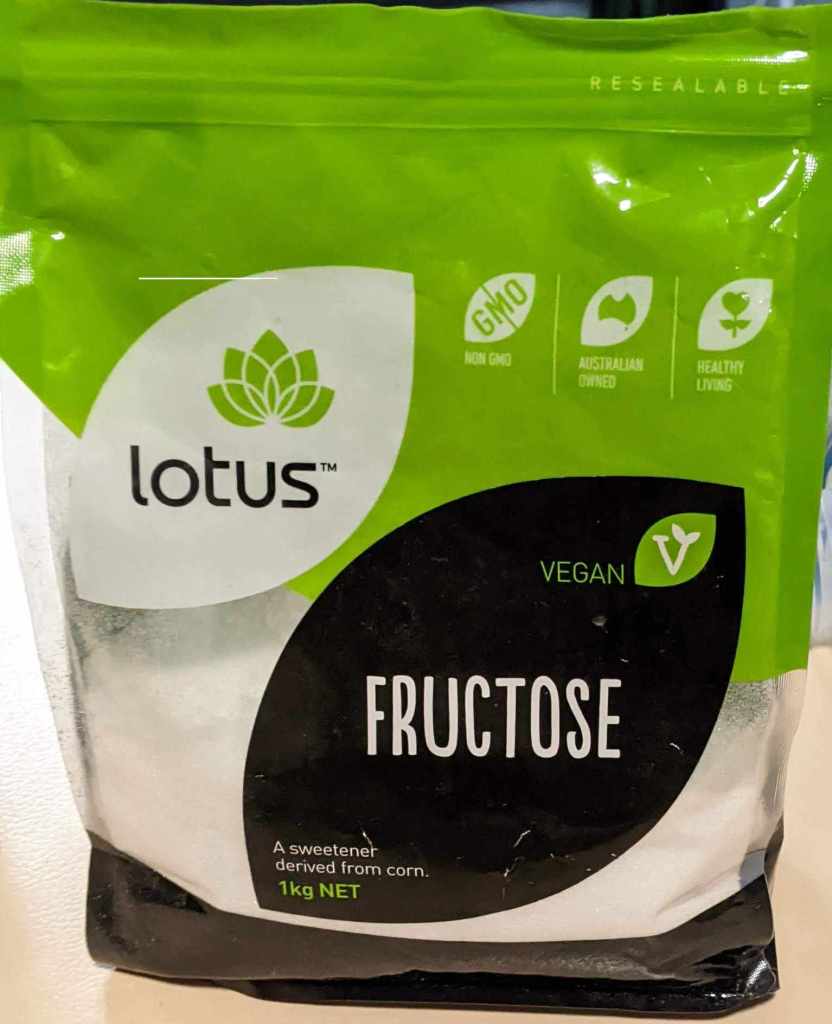In my quest to maximise carb intake I have spent a small fortune on energy gels and powders. In an effort to reduce my expenditure and make my running hobby more sustainable I have been experimenting with homemade drink mixes. It turns out it’s super easy and significantly cheaper to make your own. This post will outline the recipe I have been testing and how to make it. All for a fraction of the cost of typical running nutrition products.

Drink Mix Recipe
I hate long-winded recipe intros. Here’s the recipe – it’s my homemade replica of SiS Betafuel with extra sodium. Details on how and why I made it are below.
Ingredients
- 46g Maltodextrin
- 36.8g Fructose
- 1 x Koda electrolyte sachet (430mg sodium)
Method
- Place a bowl on kitchen scales and tare the weight
- Add maltodextrin, fructose and Koda sachet to the bowl at correct weights
- Mix the powders together
- Pour through a funnel into a hydration flask (500ml)
- Partially fill the flask, close the lid and shake vigorously
- Fill the rest of the flask and it’s ready to drink

Nutritional Information
| Ingredient | Weight (g) | kCal | Carb (g) | Sodium (mg) | Cost / Serve |
|---|---|---|---|---|---|
| Maltodextrin | 46 | 175.9 | 43.7 | 23.0 | $0.459 |
| Fructose | 36.8 | 151.3 | 36.8 | 0 | $0.607 |
| Salt (Koda electolyte) | 4 | 7.0 | 0 | 430.0 | $1.398 |
| Total | 86.8 | 334.2 | 80.5 | 453.0 | $2.463 |
Carbohydrate Intake Goals
For long runs exceeding 3 hours, I target carbohydrate intake above 90 grams per hour. Exceeding the 60 grams per hour limit requires fueling with both glucose and fructose, as they are absorbed through different pathways. While the optimal ratio is debated, some research suggests it may not be a single fixed value, but rather depend on your individual goals.
The below figure from mysportscience and the associated article give a good explanation of there being no optimal ratio and it all depends on your carb intake goals (I think there is an error in the diagram and it should read 1:0.8 ratio at the high end).

Source: mysportscience.com
Glucose to Fructose Ratio
I’ve had success with SiS Betafuel in the past. Their 1:0.8 glucose to fructose ratio, with 80g of carbohydrates, provides a good base for targeting that greater than 100g/hour intake goal. I’m using that ratio in my homemade recipe as a starting point. Down the line, I’ll experiment with different ratios, maybe for shorter runs. I’ve also found straight maltodextrin in water effective – its mild flavor makes it super easy to get those calories in without taste fatigue
Key Ingredients
Maltodextrin
Maltodextrin is a highly refined sugar derived from corn starch. It is minimally flavoured and dissolves well into water. It’s considered a complex carbohydrate but it breaks down into glucose—a simple sugar easily processed by the body.
I sourced my maltodextrin through Bulk Nutrients because they are local and ship quickly to my house. I bought 5kg for a total of $49.85 including postage. It can definitely be sourced cheaper from homebrew shops which I plan to investigate in the future.

Fructose
Fructose is a simple sugar derived from fruit. Once reaching the maximum of 60g carb per hour of glucose we need to introduce fructose into the mix. It is quite sweet compared to maltodextrin so it adds a stronger and sweeter flavour to the drink mix.
I bought my 2 x 1kg bags from ebay, it cost me $33 all up.

Sodium and Flavouring
In order to get both flavouring and sodium content in my drink I have opted to use the Koda eletrolyte sachets. These provide 430mg of sodium and a subtle flavouring to the drink. I am going to experiment with unflavoured mixes and possible replace this with table salt. This is the most expensive ingredient of the whole mix at $1.39 per serving.
Down the track I intend to get a sweat test done so I can target my sodium intake with more precision. At this stage I am going to stick with the Koda dosage because I know it works for me.
Cost per serving
As shown in the recipe information table this mix costs $2.47 per serving and each serving contains 334 kCal. This makes each serving equivalent to approximately three typical energy gels. The cheapest energy gels cost around $2 per 100 kCal serving while the normalised cost of this mix is $0.74 per 100 kCal serving. There are big savings to be made with this mix.
The cost could be further reduced if I find a cheaper source of maltodextrin possibly from the homebrew shop. The cost could be also significantly cut if I ditched the flavoured electrolyte mix in favour of table salt. This could bring the cost down to $1 per 80g carb serving
Tonicity
Tonicity refers to the concentration of solutes, mainly sugars and electrolytes (salts), compared to the concentration of these solutes in the body’s fluids, specifically blood plasma. This comparison determines how quickly and effectively the drink is absorbed by the body.
There are three main categories of sports drinks based on their tonicity:
- Hypotonic: These drinks have a lower concentration of solutes than blood plasma. This allows for faster absorption of fluids into the bloodstream, making them ideal for rehydration during moderate-intensity exercise or in hot and humid environments.
- Isotonic: These drinks have a similar concentration of solutes to blood plasma. They provide a balance of fluids, electrolytes, and carbohydrates, making them suitable for maintaining hydration and energy levels during moderate to high-intensity exercise.
- Hypertonic: These drinks have a higher concentration of solutes than blood plasma. They are slower to absorb due to the higher concentration, but they can provide a significant energy boost during prolonged, high-intensity exercise. However, they are not recommended for rehydration purposes as they can draw fluids out of the body and worsen dehydration.
| Tonicity | Good For | Concentration | Osmolarity |
|---|---|---|---|
| Hypotonic | Hydration over nutrition | Lower than blood | < 275 |
| Hypertonic | Nutrition over hydration | Higher than blood | > 295 |
| Isotonic | Hydration and nutrition | Similar to blood | 275–295 |
SiS claim that their Betafuel drink is isotonic, my drink is almost a direct copy of this drink mix. Based upon my little research into this topic I believe that my drink mix is well and truly hypertonic. As such I focus on trying to get additional hypotonic fluids in alongside my drink mix to prevent dehydration issues.
Results so Far
I have been testing this drink mix on all of my long runs lately and have been having good results. I aim to drink an 80g mix per hour and a Koda or Winners gel which gets me to 107g/hr of carb intake. My body has been handling it well with no GI distress.
This coming weekend I am running Gone Nuts 101km race . I am going to put the mix to the ultimate test and try to use this gel + drink mix strategy for the duration of the race. To ensure I stay on top of hydration I will use a 1.5L bladder in my pack with electrolytes in it and use my 500ml hydration flasks for the drink mix.
Going forward I am going to explore the following options to refine the drink mix and the process for drinking it
- Using table salt instead of off the shelf electrolytes to reduce cost
- Testing out naked unflavoured mix (additional cost savings)
- Using a vacuum sealer to make easy to use sachets that make filling a flask easy on the run
- Finding a cheaper source of maltodextrin and fructose
- Look into alternative flavouring options
After this weekend I will do a follow up post / race report from Gone Nuts to see how this strategy holds up in a long race. Wish me luck!!

Joseph Nunn: An avid trail runner based in Hobart, Tasmania. He loves getting out for big days on the trails with mates or racing against them.
Want to read more content like this? Subscribe to my blog and get new posts delivered straight to your inbox every 2 weeks.


How’s the flavor? Is it no flavor at all? Or just sweet/ salty from the carb and electrolyte sources? VERY crafty!!
Hi Jena, it’s fairly sweet and gets some grapefruit flavouring from the electrolyte sachet. Not too salty but I am used to that amount of sodium in my drink. I am already thinking of new formulations of the mix to reduce cost and improve taste so keep an eye out for Drink Mix 2.0 😉 Also, I will try homemade energy gels, which I’ll be sure to post about.
Great to be able to tailor a mix to an event! I also wonder if gender and body size, physiology etc are significant to our ability to absorb carbs. Cycling in particular has big variability in the ‘type’ of rider – high muscle sprinter vs light climber -but compete at the same events. Anyhow – many thanks from another Taswegion – all the best with the run – keen to hear your feedback.
Hi Nic, everyone certainly has a different tolerance to carb intake. It is possible to train to absorb more carbs. I train myself to take in a high amount of carb per hour by gradually increasing the intake on long workouts over a period of weeks/months. It works for me for the most part although I still haven’t solved the mystery of nutrition for extra-long ultras, it’s a hard one to crack. I work with your cousin Nathan. When I saw your email I thought it was him for a second haha. Tassie is a small place
Great post! Hydration is crucial, especially when we’re busy. I love using a hydration drink mix to keep my energy up throughout the day. It’s a simple way to ensure I’m staying hydrated and focused.
Hey, 4 grams of salt is 4,000mg! You’ve got way too much salt in your recipe (ten times as much if you are targeting 430mg)!
Hey you’re right, there’s a mistake in the table, I’ll fix that. I use the Koda electrolyte tabs which have 430mg in them so I don’t actually put 4g in the mix
Actually the 4g is the total weight of the electrolyte tablet. The effervescent tab contains 430mg sodium
Have you gone on to test using table salt? I’m eager to try your mix, however, I will be using table salt to start with. That, and I’ll be using it for XC Marathon mountain biking.
Hi Dan, I haven’t yet but am still planning on doing it. I am stuck trying to decide how much sodium I need. Sometimes I make the drink without any sodium and add electrolytes to my other drink. The only difficulty with using table salt is you need a fairly accurate set of scales to work out how much to add. I guess a 1/8 tsp might be a decent measure to add per 500ml mix. Another thing I have been doing lately is changing the ratio back to 2:1, makes the taste more palatable for me and I am back to targetting 70-90g/hr so it works well for me.
Hi Joe, just as an update for you. I made my mix using your weight suggestions. I used a jewellers scale to get the correct amount of salt (1.72g), upscaling the recipe to 2l – 4 times your recipe (size of my Camelbak).
After doing a 60km ride, I can say that the mix definitely does do what it’s meant to. One thing though, it’s extremely sweet. I haven’t used any flavourant, gone with the unflavoured powders. This was acompanied by a 500ml bottle of SIS Hydro. At the end of the ride, I had about 500ml of mix remaining.
All in all, I think its a very good substitute for the over the counter drinks.